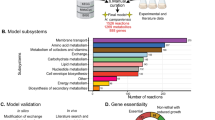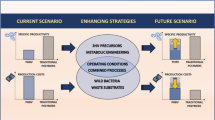Abstract
Naturally degradable bioplastic polyhydroxyalkanoate (PHA) is a promising biopolymer and its physical properties could be changed by introducing of different monomers such as 3-hydroxybutyrate (3HB), 3-hydroxyvalerate (3HV), and 3-hydroxyhexanoate (3HHx). To produce poly(3-hydroxybutyrate-co-3-hydroxyvalerate) P(3HB-co-3HV)) including a high fraction of hydroxyvalerate, we introduced ctfAB into engineered Escherichia coli YJ200 possessing a pLW487 vector containing bktB, phaB, and phaC under control of the trc promoter. To enhance the HV fraction of P(3HB-co-3HV), the optimal concentrations of propionate, which acts as a precursor of 3HV and isopropyl β-D-1-thiogalactopyranoside, were determined and found to be 0.1 mM and 0.3%, respectively. Under the optimized conditions, E. coli, YJ201 produced P(3HB-co-3HV) containing a large amount of 3HV. Comparison with other CoA transferases showed that CtfAB produced relatively lower molecular weight copolymers. This demonstrates the necessity of identifying additional different CoA transferases, because CoA transferase can affect both the monomer fraction and molecular weight of polymers.
Similar content being viewed by others
References
Huijberts, G. N., G. Eggink, P. de Waard, G. W. Huisman, and B. Witholt (1992) Pseudomonas putida KT2442 cultivated on glucose accumulates poly(3-hydroxyalkanoates) consisting of saturated and unsaturated monomers. Appl. Environ. Microbiol. 58: 536–544.
McCool, G. J. and M. C. Cannon (1999) Polyhydroxyalkanoate inclusion body-associated proteins and coding region in Bacillus megaterium. J. Bacteriol. 181: 585–592.
Jeon, J. M., C. J. Brigham, Y. H. Kim, H. J. Kim, D. H. Yi, H. Kim, C. K. Rha, A. J. Sinskey, and Y. H. Yang (2014) Biosynthesis of poly(3-hydroxybutyrate-co-3-hydroxyhexanoate) (P(HB-co-HHx)) from butyrate using engineered Ralstonia eutropha. Appl. Microbiol. Biotechnol. 98: 5461–5469.
Jeon, J. M., H. J. Kim, S. K. Bhatia, C. Sung, H. M. Seo, J. H. Kim, H. Y. Park, D. Lee, C. J. Brigham, and Y. H. Yang (2017) Application of acetyl-CoA acetyltransferase (atoAD) in Escherichia coli to increase 3-hydroxyvalerate fraction in poly (3-hydroxybutyrate-co-3-hydroxyvalerate). Bioprocess Biosyst. Eng. 40: 781–789.
Bhatia, S. K., R. K. Bhatia, and Y. H. Yang (2016) Biosynthesis of polyesters and polyamide building blocks using microbial fermentation and biotransformation. Rev. Environ. Sci. Biotechnol. 15: 639–663.
Kulpreecha, S., A. Boonruangthavorn, B. Meksiriporn, and N. Thongchul (2009) Inexpensive fed-batch cultivation for high poly(3-hydroxybutyrate) production by a new isolate of Bacillus megaterium. J. Biosci. Bioeng. 107: 240–245.
Du, C., J. Sabirova, W. Soetaert, and C. S. K. Lin (2012) Polyhydroxyalkanoates production from low-cost sustainable raw materials. Curr. Chem. Biol. 6: 14–25.
Koller, M. and G. Braunegg (2018) Advanced approaches to produce polyhydroxyalkanoate (PHA) biopolyesters in a sustainable and economic fashion. EBTJ. 2: 89–103.
Hong, Y. G., Y. M. Moon, J. W. Hong, T. R. Choi, H. R. Jung, S. Y. Yang, D. W. Jang, Y. R. Park, C. Brigham, J. S. Kim, Y. K. Lee, and Y. H. Yang (2019) Discarded egg yolk as an alternate source of poly(3-hydroxybutyrate-co-3-hydroxyhexanoate). J. Microbiol. Biotechnol. 29: 382–391.
Bhatia, S. K., J. H. Kim, M. S. Kim, J. Kim, J. W. Hong, Y. G. Hong, H. J. Kim, J. M. Jeon, S. H. Kim, J. Ahn, H. Lee, and Y. H. Yang (2018) Production of (3-hydroxybutyrate-co-3-hydroxyhexanoate) copolymer from coffee waste oil using engineered Ralstonia eutropha. Bioproc. Biosyst. Eng. 41: 229–235.
Bhatia, S. K., R. Gurav, T. R. Choi, H. R. Jung, S. Y. Yang, H. S. Song, J. M. Jeon, J. S. Kim, Y. K. Lee, and Y. H. Yang (2019) Poly(3-hydroxybutyrate-co-3-hydroxyhexanoate) production from engineered Ralstonia eutropha using synthetic and anaerobically digested food waste derived volatile fatty acids. Int. J. Biol. Macromol. 133: 1–10.
Chuah, J. A., M. Yamada, S. Taguchi, K. Sudesh, Y. Doi, and K. Numata (2013) Biosynthesis and characterization of polyhydroxyalkanoate containing 5-hydroxyvalerate units: effects of 5HV units on biodegradability, cytotoxicity, mechanical and thermal properties@@. Polym. Degrad. Stab. 98: 331–338.
Li, Z. J., Z. Y. Shi, J. Jian, Y. Y. Guo, Q. Wu, and G. Q. Chen (2010) Production of poly(3-hydroxybutyrate-co-4-hydroxybutyrate) from unrelated carbon sources by metabolically engineered Escherichia coli. Metab. Eng. 12: 352–359.
Muzaiyanah, A. R. and A. A. Amirul (2013) Studies on the microbial synthesis and characterization of polyhydroxyalkanoates containing 4-hydroxyvalerate using γ-valerolactone. Appl. Biochem. Biotechnol. 170: 1194–1215.
Lee, S. Y. (1996) Bacterial polyhydroxyalkanoates. Biotechnol. Bioeng. 49: 1–14.
Bhatia, S. K., R. Gurav, T. R. Choi, H. R. Jung, S. Y. Yang, Y. M. Moon, H. S. Song, J. M. Jeon, K. Y. Choi, and Y. H. Yang (2019) Bioconversion of plant biomass hydrolysate into bioplastic (polyhydroxyalkanoates) using Ralstonia eutropha 5119. Bioresour. Technol. 271: 306–315.
Yang, Y. H., C. J. Brigham, C. F. Budde, P. Boccazzi, L. B. Willis, M. A. Hassan, Z. A. M. Yusof, C. K. Rha, and A. J. Sinskey (2010) Optimization of growth media components for polyhydroxyalkanoate (PHA) production from organic acids by Ralstonia eutropha. Appl. Microbiol. Biotechnol. 87: 2037–2045.
Zheng, Y., J. C. Chen, Y. M. Ma, and G. Q. Chen (2020) Engineering biosynthesis of polyhydroxyalkanoates (PHA) for diversity and cost reduction. Metab. Eng. 58: 82–93.
Sim, S. J., K. D. Snell, S. A. Hogan, J. Stubbe, C. Rha, and A. J. Sinskey (1997) PHA synthase activity controls the molecular weight and polydispersity of polyhydroxybutyrate in vivo. Nat. Biotechnol. 15: 63–67.
Meng, D. C., Z. Y. Shi, L. P. Wu, Q. Zhou, Q. Wu, J. C. Chen, and G. Q. Chen (2012) Production and characterization of poly(3-hydroxypropionate-co-4-hydroxybutyrate) with fully controllable structures by recombinant Escherichia coli containing an engineered pathway. Metab. Eng. 14: 317–324.
Cruz, M. V., D. Araújo, V. D. Alves, F. Freitas, and M. A. Reis (2016) Characterization of medium chain length polyhydroxyalkanoate produced from olive oil deodorizer distillate. Int. J. Biol. Macromol. 82: 243–248.
Park, D. H. and B. S. Kim (2011) Production of poly(3-hydroxybutyrate) and poly(3-hydroxybutyrate-co-4-hydroxybutyrate) by Ralstonia eutropha from soybean oil. N Biotechnol. 28: 719–724.
Sun, J., F. Shozui, M. Yamada, K. Matsumoto, K. Takase, and S. Taguchi (2010) production of P(3-hydroxybutyrate-co-3-hydroxyhexanoate-co-3-hydroxyoctanoate) terpolymers using a chimeric PHA synthase in recombinant Ralstonia eutropha and Pseudomonas putida. Biosci. Biotechnol. Biochem. 74: 1716–1718.
Liu, X. W., H. H. Wang, J. Y. Chen, X. T. Li, and G. Q. Chen (2009) Biosynthesis of poly(3-hydroxybutyrate-co-3-hydroxyvalerate) by recombinant Escherichia coli harboring propionyl-CoA synthase gene (prpE) or propionate permease gene (prpP). Biochem. Eng. J. 43: 72–77.
Yang, Y. H., C. J. Brigham, E. Song, J. M. Jeon, C. K. Rha, and A. J. Sinskey (2012) Biosynthesis of poly(3-hydroxybutyrate-co-3-hydroxyvalerate) containing a predominant amount of 3-hydroxyvalerate by engineered Escherichia coli expressing propionate-CoA transferase. J. Appl. Microbiol. 113: 815–823.
Bhatia, S., D. H. Yi, H. J. Kim, J. M. Jeon, Y. H. Kim, G. Sathiyanarayanan, H. M. Seo, J. H. Lee, J. H. Kim, K. Park, C. J. Brigham, and Y. H. Yang (2015) Overexpression of succinyl-CoA synthase for poly(3-hydroxybutyrate-co-3-hydroxyvalerate) production in engineered Escherichia coli BL21 (DE3). J. Appl. Microbiol 119: 724–735.
Park, S. J., W. S. Ahn, P. R. Green, and S. Y. Lee (2001) Biosynthesis of poly(3-hydroxybutyrate-co-3-hydroxyvalerateco-3-hydroxyhexanoate) by metabolically engineered Escherichia coli strains. Biotechnol. Bioeng. 74: 81–86.
Jung, H. R., S. Y. Yang, Y. M. Moon, T. R. Choi, H. S. Song, S. K. Bhatia, R. Gurav, E. J. Kim, B. G. Kim, and Y. H. Yang (2019) Construction of efficient platform Escherichia coli strains for polyhydroxyalkanoate production by engineering branched pathway. Polymers. 11: 509.
Lu, C., L. Yu, S. Varghese, M. Yu, and S. T. Yang (2017) Enhanced robustness in acetone-butanol-ethanol fermentation with engineered Clostridium beijerinckii overexpressing adhE2 and ctfAB. Bioresour. Technol. 243: 1000–1008.
Lin, H., N. M. Castro, G. N. Bennett, and K. Y. San (2006) Acetyl-CoA synthetase overexpression in Escherichia coli demonstrates more efficient acetate assimilation and lower acetate accumulation: a potential tool in metabolic engineering. Appl. Microbiol. Biotechnol. 71: 870–874.
Yang, Y. H., C. Brigham, L. Willis, C. K. Rha, and A. Sinskey (2011) Improved detergent-based recovery of polyhydroxyalkanoates (PHAs). Biotechnol. Lett. 33: 937–942.
Braunegg, G., B. Sonnleitner, and R. M. Lafferty (1978) Rapid gas-chromatographic method for determination of poly-betahydroxybutyric acid in microbial biomass. Eur. J. Appl. Microbiol. Biotechnol. 6: 29–37.
York, G. M., J. Lupberger, J. Tian, A. G. Lawrence, J. Stubbe, and A. J. Sinskey (2003) Ralstonia eutropha H16 encodes two and possibly three intracellular poly[D-(-)-3-hydroxybutyrate] depolymerase genes. J. Bacteriol. 185: 3788–3794.
Miyake, M., J. Schnackenberg, R. Kurane, and Y. Asada (2000) Phosphotransacetylase as a key factor in biological production of polyhydroxybutyrate. Appl. Biochem. Biotechnol. 84–86: 1039–1044.
Rhie, H. G. and D. Dennis (1995) The function of ackA and pta genes is necessary for poly(3-hydroxybutyrate-co-3-hydroxyvalerate) synthesis in recombinant pha+ Escherichia coli. Can. J. Microbiol. 41: 200–206.
Budde, C. F., A. E. Mahan, J. Lu, C. Rha, and A. J. Sinskey (2010) Roles of multiple acetoacetyl coenzyme A reductases in polyhydroxybutyrate biosynthesis in Ralstonia eutropha H16. J. Bacteriol. 192: 5319–5328.
Hahn, S. K., Y. K. Chang, and S. Y. Lee (1995) Recovery and characterization of poly(3-hydroxybutyric acid) synthesized in Alcaligenes eutrophus and recombinant Escherichia coli. Appl. Environ. Microbiol. 61: 34–39.
Theodorou, E. C., M. C. Theodorou, and D. A. Kyriakidis (2013) Regulation of poly-(R)-(3-hydroxybutyrate-co-3-hydroxyvalerate) biosynthesis by the AtoSCDAEB regulon in phaCAB+ Escherichia coli. Appl. Microbiol. Biotechnol. 97: 5259–5274.
Kalia, V. C., S. Lal, Rashmi, A. Chauhan, and G. Bhattacharyya (2015) In silico reconstitution of novel routes for microbial plastic. pp. 299–315. In: V. C. Kalia (ed.). Microbial Factories: Biodiversity, Biopolymers, Bioactive Molecules. Springer, New Delhi, India.
Park, S. J., J. I. Choi, and S. Y. Lee (2005) Short-chain-length polyhydroxyalkanoates: synthesis in metabolically engineered Escherichia coli and medical applications. J. Microbiol. Biotechnol. 15: 206–215.
Moon, Y. M., S. Y. Yang, T. R. Choi, H. R. Jung, H. S. Song, Y. H. Han, H. Y. Park, S. K. Bhatia, R. Gurav, K. Park, J. S. Kim, and Y. H. Yang (2019) Enhanced production of cadaverine by the addition of hexadecyltrimethylammonium bromide to whole cell system with regeneration of pyridoxal-5′-phosphate and ATP. Enzyme Microb. Technol. 127: 58–64.
Acknowledgments
This work was supported by Research Program to solve social issues of the National Research Foundation of Korea (NRF) funded by the Ministry of Science and ICT (2017M3A9E4077234) and National Research Foundation of Korea (NRF) (NRF-2017R1D1A1B03033594, NRF- 2019M3E6A1103979 and NRF-2019R1F1A1058805). In addition, this work was also supported by the polar academic program (PAP, PE18900). This paper was also supported by Konkuk University Researcher Fund in 2019.
The authors declare no conflict of interest.
Neither ethical approval nor informed consent was required for this study.
Author information
Authors and Affiliations
Corresponding authors
Additional information
Publisher's Note Springer Nature remains neutral with regard to jurisdictional claims in published maps and institutional affiliations.
Rights and permissions
About this article
Cite this article
Choi, TR., Jeon, JM., Bhatia, S.K. et al. Production of Low Molecular Weight P(3HB-co-3HV) by Butyrateacetoacetate CoA-transferase (cftAB) in Escherichia coli. Biotechnol Bioproc E 25, 279–286 (2020). https://doi.org/10.1007/s12257-019-0366-1
Received:
Revised:
Accepted:
Published:
Issue Date:
DOI: https://doi.org/10.1007/s12257-019-0366-1




